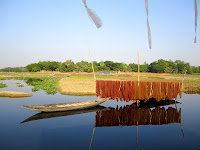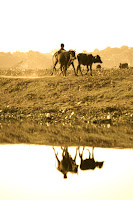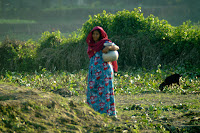When we filled out the housing questionnaire for Dhaka, one of the only items we requested was some green space for gardening and for Ceiba to play. We got assigned an apartment... without one blade of grass.
Honestly, no hard feelings (I got over it). The apartment is uber-nice, with a floor plan WAY nicer than most of the embassy houses. And we don't have any giant, three-story, scary staircases to worry about.
And in the gardening category, the
sunny rooftop is working out swell. Our gardener and I talk every day and go over what to plant next. We supply him with seeds and sincere interest, he grows and tends to some great homegrown veggies (and the occasional papaya), and we lavish him with thanks and smiles. Ceiba helps me pick lettuce at least 3 times a week lately, which Chris enjoys in a salad everyday for work. I use several of the near perennial herbs in our meals. We anxiously await the next vegetables to ripen, as do our apartment neighbors and all of our house staff. Nothing goes to waste and everyone shares in the good fortune (and grocery $ savings) of our own garden. Our helpers teach us how to cook local produce, and we share items that would be expensive or nonexistent on the local economy.
top: (l to r) zucchini/squash/broccoli, Chris/Avocet/Ceiba grill dogs, our salad patch 1 of 3
below: (l to r) gourd/pumpkins, salad patch, our one wonderful smelling rose
top: (l to r) gourds/pumpkins, basil, tomatoes
below: (l to r) ginger, crown of thorns/euphorbia mili, papayas (sex yet tbd)
top: (l to r) tomatoes, eggplant/onion/herbs/cauliflower/cabbage, parsley
below: (l to r) veggie row!
top: (l to r) chives/bougainvillea/spinach/papaya, our good female papaya, lemongrass
Our current crops:
tomatoes (2 kinds), broccoli, cauliflower, cabbage, zucchini, yellow squash, gooseneck gourds, local green pumpkin, lettuce/mesclun (6 types), spinach, capsicum/peppers (green & colored), jalapenos, green chilies, ginger (from a prolific start in our pantry), pineapples (from leftover tops of fruit), eggplant, yellow onions.
And our herbs on tap:
oregano, chives, lemongrass, sage, parsley (2 kinds), dill, basil, rosemary, thyme, mint.
Khalec, our gardener, now understand crop rotation better, and he now has 3 separate beds of salad greens, all growing at different stages so that we have a constant supply. Lettuce is expensive here, not much variation and can be difficult to sanitize well, so having our own supply is super.
We also have 3 small lime trees, 3 papaya trees and a constant assortment of ginger and other flowers. We learned from our gardener that papayas are either male (flowering, flowering, showy, but no fruit) or female (all work to fruit and no show). He has one great female! The other 2 were males, but he cut them down and started new plants in hopes for females. We're waiting to see the outcome.
The space and the crops it produce are not enormous, but we enjoy them both to the fullest! Plants grow and produce so quickly here. My Grandpa Wilbur would be thrilled to see what a great garden we are helping tend :)

















































































































